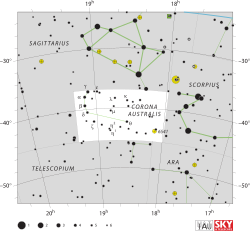Corona Australis
| Constellation | |

|
|
| Abbreviation | CrA |
|---|---|
| Genitive |
|
| Pronunciation | /kəˈroʊnə ɔːˈstreɪlᵻs/ or /kəˈroʊnə ɔːˈstraɪnə/, genitive /kəˈroʊni/ |
| Symbolism | The Southern Crown |
| Right ascension | 17h 58m 30.1113s–19h 19m 04.7136s |
| Declination | −36.7785645°–−45.5163460° |
| Family | Hercules |
| Area | 128 sq. deg. (80th) |
| Main stars | 6 |
|
Bayer/Flamsteed stars |
14 |
| Stars with planets | 2 |
| Stars brighter than 3.00m | 0 |
| Stars within 10.00 pc (32.62 ly) | 0 |
| Brightest star | α CrA (4.10m) |
| Nearest star |
HD 166348 (42.26 ly, 12.96 pc) |
| Messier objects | 0 |
| Meteor showers | Corona Australids |
| Bordering constellations |
|
|
Visible at latitudes between +40° and −90°. Best visible at 21:00 (9 p.m.) during the month of August. |
|
Corona Australis or Corona Austrina is a constellation in the Southern Celestial Hemisphere. Its Latin name means "southern crown", and it is the southern counterpart of Corona Borealis, the northern crown. One of the 48 constellations listed by the 2nd-century astronomer Ptolemy, it remains one of the 88 modern constellations. The Ancient Greeks saw Corona Australis as a wreath rather than a crown and associated it with Sagittarius or Centaurus. Other cultures have likened the pattern to a turtle, ostrich nest, a tent, or even a hut belonging to a rock hyrax.
Although fainter than its namesake, the oval- or horseshoe-shaped pattern of its brighter stars renders it distinctive. Alpha and Beta Coronae Australis are the two brightest stars with an apparent magnitude of around 4.1. Epsilon Coronae Australis is the brightest example of a W Ursae Majoris variable in the southern sky. Lying alongside the Milky Way, Corona Australis contains one of the closest star-forming regions to the Solar System—a dusty dark nebula known as the Corona Australis Molecular Cloud, lying about 430 light years away. Within it are stars at the earliest stages of their lifespan. The variable stars R and TY Coronae Australis light up parts of the nebula, which varies in brightness accordingly.
The name of the constellation was entered as "Corona Australis" when the International Astronomical Union (IAU) established the 88 modern constellations in 1922. In 1932, the name was instead recorded as "Corona Austrina" when the IAU's commission on notation approved a list of four-letter abbreviations for the constellations. Although the four-letter abbreviations were repealed in 1955, this alternative name has persisted alongside the original. The IAU presently uses "Corona Australis" exclusively.
...
Wikipedia
